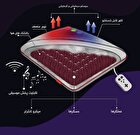Iranian Researchers Study Effects of Diabetes on Hammertoe

The Iranian researchers investigated the effects of hammertoe on the ligaments of the toes of a person with advanced diabetes.
Hammertoe is a foot condition that makes the middle joint of a toe permanently bend up. It’s caused by an imbalance between the muscles, tendons, and ligaments in the feet, and it can be painful if left untreated.
When a toe contracts, it usually straightens back out. Over time, either due to arthritis, diabetes, or overuse, it can stay in a clawed or hammered position causing problems.
According to statistics, there are more than 400 million people with diabetes in the world, and 32 to 39 percent of diabetic people will undergo hammertoe.
The change of shape in diabetics is a phenomenon that increases the risk of wound formation.
In this research, the formation of a precise three-dimensional model of the diabetic foot that has undergone a change in shape and the changes that occur due to the deformation of a hammertoe compared to a healthy foot was considered.
The study is primarily important for people with diabetes to be able to know more precisely the risks that will occur for them due to the simultaneous occurrence of diabetes and the change in the shape of their feet.
The present work may help them avoid the occurrence of foot ulcers and also the change in the shape of their toes.
In the next stages, the results of the project can be used for designing shoes and shoe soles and reconstructing the surgical process of deviation correction.
Later on, designing and testing of shoe soles, creating optimal conditions for hammer toe, as well as applying various surgical methods to correct the deviation in modeling will be pursued.
In most designs, with the aim of modeling a deformed foot (for example, a foot with a hump of the big toe), the healthy foot is modeled and defects and damage are manually entered into the model.
But in the present work, the foot with deformation was modeled directly, which will make the results closer to reality.
Also, the interaction between finite element modeling and musculoskeletal in the present work is among the advantages that can compete with other research in this field.
4155/g























